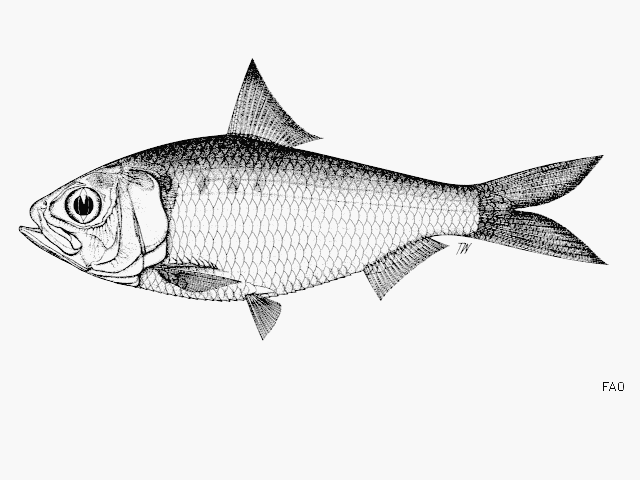Hilsa
kelee
(Cuvier,
1829)
Kelee shad
View all media / Upload your photos and videos
Expand all
Classification / Names
Teleostei (teleosts) > Clupeiformes (Herrings) >
Dorosomatidae (Gizzard shads and sardinellas)
Etymology: Hilsa: Bangladesh and Bengali local name for a fish
More on author:
Cuvier.
Environment / milieu / depth range / climate zone / distribution range
Distribution
Indo-West Pacific: probably all coasts of Indian Ocean, from Gulf of Oman and Gulf of Aden south to Durban and Madagascar, across the Bay of Bengal, Gulf of Thailand, Java Sea and north to Hong Kong and east to Papua New Guinea and possibly further (Ref. 188).
Maps

Hilsa kelee / Native range
AquaMaps Data sources:
GBIF
OBIS
This map was computer-generated and has not yet been reviewed.

Hilsa kelee / Suitable habitat
AquaMaps Data sources:
GBIF
OBIS
This map was computer-generated and has not yet been reviewed.

Hilsa kelee / Point map
AquaMaps Data sources:
GBIF
OBIS
This map was computer-generated and has not yet been reviewed.

Hilsa kelee / Year 2050
AquaMaps Data sources:
GBIF
OBIS
This map was computer-generated and has not yet been reviewed.
Length at first maturity / Size / Weight / Age
Short description
Dorsal spines (total): 0; Dorsal soft rays (total): 16 - 19; Anal spines: 0; Anal soft rays: 17 - 23. Diagnosis: Body fairly deep and compressed, belly with distinct keel of scutes; top of head with numerous fronto-parietal striae; upper jaw with median notch; gillrakers about 100 to 175, those on inner arches distinctly curled; outer row of gill filaments on first arch not more than half length of gillrakers; a series of small triangular scales above axil of pectoral fin; hind part of body scales perforated (Ref. 188). A black spot behind gill cover, usually followed by up to 10 spots along flank (Ref. 188). Description: Body fusiform, fairly deep and compressed; belly with a distinct keel of scutes (Ref. 3107). Top of head with numerous, 8-14, fronto-parietal striae; upper jaw with a distinct median notch; 2 supramaxillae present (Ref. 188, 3107, 3259, 30573). Gillrakers very fine and numerous, 75-175 on lower limb of first gill arch, those on inner arches curled; number increasing with growth (Ref. 3107, 3259). Dorsal fin origin a little before mid-point of body; anal fin short and well behind dorsal fin base; dorsal fin with 3-4 unbranched and 13-15 branched rays, anal fin with 2-4 unbranched and 15-19 branched rays, pectoral fin with 1 unbranched and 12-15 branched rays, pelvic fin with 1 unbranched and 7 branched rays (Ref. 3107, 3259). Scales on longitudinal series 39-44; posterior part of scales with perforations (Ref. 3107, 3259). Sharp keeled scutes present along belly; with 15-17 pre-pelvic scutes and 12-14 post-pelvic scutes (Ref. 28, 3259). Colouration: Back blue-green, flanks silvery with a black spot behind gill opening and up to 10 similar spots along flanks, or high up near dorsal profile (Ref. 188, 3107, 3259, 12484).
Biology
Found in coastal waters (Ref. 3107, 30573); marine, pelagic, but entering estuaries and able to tolerate quite low salinities (7 ppt) (Ref. 188). Feeds chiefly on phytoplankton, mainly diatoms, also dinoflagellates, but also copepods, molluscan and crustacean larvae, prawns, amphipods and polychaetes (Ref. 188). Spawns, at least in Godavari estuary, around February (Ref. 188). Marketed fresh, dried, dried-salted and boiled. Made into fish balls.
Main reference
Whitehead, P.J.P. 1985 FAO Species Catalogue. Vol. 7. Clupeoid fishes of the world (suborder Clupeoidei). An annotated and illustrated catalogue of the herrings, sardines, pilchards, sprats, shads, anchovies and wolf-herrings. FAO Fish. Synop. 125(7/1):1-303. Rome: FAO. (Ref. 188)
IUCN Red List Status (Ref. 125652)
Least Concern (LC); date assessed: July 11 2018
CITES (Ref. 131153)
Not Evaluated
CMS (Ref. 116361)
Not Evaluated
Threat to humans
Harmless
More information
- Countries
- FAO areas
- Ecosystems
- Occurrences
- Introductions
- Stocks
- Ecology
- Diet
- Food items
- Food consumption
- Ration
- Common names
- Synonyms
- Metabolism
- Predators
- Ecotoxicology
- Reproduction
- Maturity
- Spawning
- Spawning aggregation
- Fecundity
- Eggs
- Egg development
- Age/Size
- Growth
- Length-weight
- Length-length
- Length-frequencies
- Morphometrics
- Morphology
- Larvae
- Larval dynamics
- Recruitment
- Abundance
- References
- Aquaculture
- Aquaculture profile
- Strains
- Genetics
- Allele frequencies
- Heritability
- Diseases
- Processing
- Mass conversion
- Vision
- Pictures
- Stamps, Coins Misc.
- Sounds
- Ciguatera
- Speed
- Swim. type
- Gill area
- Otoliths
- Brains
Estimates based on models
Preferred temperature (Ref. 123201): 25.8 - 29.1, mean 28.3 °C (based on 772 cells).
Phylogenetic diversity index (Ref. 82804): PD50 = 1 [Uniqueness, from 0.5 = low to 2.0 = high].
Bayesian length-weight: a=0.01023 (0.00643 - 0.01629), b=3.03 (2.90 - 3.16), in cm total length, based on LWR estimates for this species & (Sub)family-body (Ref. 93245).
Trophic level (Ref. 69278): 2.9 ±0.3 se; Based on food items.
Generation time: 1.0 ( na - na) years. Estimated as median ln(3)/K based on 1 growth studies.
Resilience (Ref. 120179): High, minimum population doubling time less than 15 months (K=1.1).
Fishing vulnerability (Ref. 59153): Low vulnerability (18 of 100).
Climate vulnerability (Ref. 125649): High to very high vulnerability (71 of 100).
Price category (Ref. 80766): Low; Reliable: based on ex-vessel price for this species.
Nutrients (Ref. 124155): Calcium = 204 [116, 375] mg/100g; Iron = 2.01 [1.12, 3.29] mg/100g; Protein = 19.2 [18.1, 20.2] %; Omega3 = 0.411 [0.231, 0.728] g/100g; Selenium = 61.5 [30.1, 125.8] μg/100g; VitaminA = 9.95 [4.03, 23.19] μg/100g; Zinc = 1.78 [1.25, 2.60] mg/100g (wet weight);



